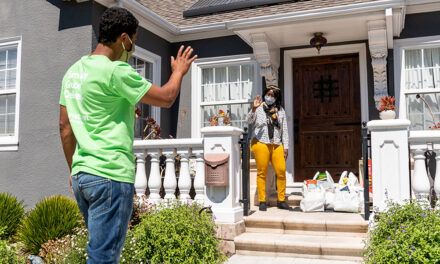
Shining A Light on Loitering

By Angela Altass
Loitering is becoming more of an issue every day, says Rick Snook, chair of the American Society for Industrial Security (ASIS) Toronto Chapter 193 and director of business development with Telus. Loitering can cause business disruption and deter customers from approaching a location, notes Snook.
“There are a few things that businesses can do to deter loitering,” says Snook. “As a Crime Prevention through Environmental Design (CPTED) practitioner, I would look at the facility and surrounding area to look for ways to change the site so it is less welcoming for loiterers.”
Some convenience stores have done some community engagement activities and were able to change the mindset of the offenders to treat the store with respect, says Snook, noting Circle K’s StreetART campaign as an example. The StreetART initiative engaged the community to create murals to deter crime by strengthening community relationships, including between youth and police.
From an electronic security approach, Snook advises utilizing cameras in conjunction with a horn speaker to provide a friendly message to people that this is not an area for loitering and, for the safety of staff and customers, to please disperse.
“A secondary trigger can be generated if they continue to stay, perhaps stating that authorities will be called,” notes Snook. “Interaction with audio has a better deterrent effect. This, however, does not solve a loitering problem; it simply transfers the issue to alternate spots.”
Loitering has become a bigger concern for businesses because of a number of issues, says Snook.
“First, we have a major issue with homelessness that we, as a society, have no real solutions for and therefore some of the loitering can be due to this, but not all,” says Snook. “Over the pandemic, we became a more reclusive society, which for many is an opposite social behaviour and, as a result, has led to people returning to social activities that may look like loitering but in reality are feeding a desire for interactive social activity. If the concern is property damage, defacing the building or causing harm to the staff or the location then it is more than loitering. Looking at the core problem that the loitering is causing will allow the problem to be reviewed and possible resolutions to be created.”
Interface Security Systems is an example of a company that offers artificial intelligence (AI) based anti-loitering systems that can detect people or vehicles and trigger scenario specific voice messages to deter loitering.
“There is a variety of technology to make the job more automated and easier,” says Dwayne Healy, vice president, business security and intelligence, Interface Systems. “For convenience stores, we do automated tours for our clients. We’ll actively jump into their video camera systems and look around the perimeter and make sure there is no one hanging around. Also, the industry has had great success in building out AI models to detect when a human being is in an area. This can help automate not just our response but alerts our 24/7 operators who are monitoring these locations. Instead of having a security guard at the door, we have a virtual guard take over. It’s interactive so we can talk to the individual and ask them to move on or we will alert the authorities. Whatever the policy is of the store, we will incorporate that into our interactive system.”
This human-plus-technology approach to security is suitable for businesses of all sizes, says Healy.
“It’s amazing how fast word of mouth travels when it comes to retailers who have taken a proactive approach,” says Healy. “My best advice is to get technology and work with a company that can back up that technology to reduce crime and loitering. Once the word starts getting out, the crime tends to move somewhere else. When the loitering moves, that storefront becomes more attractive as staff and customers will feel more secure working and shopping there.”
Organizations need to define what loitering is or consists of and have a structured policy in place to provide guidance on how to manage the issue, says Sean Sportun, vice president, national accounts and community engagement, GardaWorld. “For example, would an individual standing outside the store eating a sandwich that was just purchased be considered loitering? Or, would an individual standing around outside not buying anything be considered loitering? Or, does it come down to the individual’s appearance, whether they have purchased an item or not?”
In order to identify a solution, it is important to fully understand the root cause of the issue, states Sportun.
“Enforcement is not the sole solution to correct this type of behaviour,” says Sportun. “Looking at it from a different lens, have you ever wondered why some properties are victimized and others are not? What makes one property more susceptible to criminal attacks than others? Having a certified security professional complete a risk assessment, using CPTED principles, will identify areas of concern and recommend solutions to reduce or remove incidences of crime. In addition, having a holistic approach with key stakeholders, such as your local Business Improvement Area (BIA), community hubs/shelters, community services support and law enforcement, is recommended.”
Approaching loiterers should only be done if it is safe to do so, says Sportun.
“Staff need to be strategic and polite in their communication to avoid escalating the situation,” cautions Sportun. “For example, using threats of calling the police is not an effective approach and will likely escalate the issue. If you need to call police, don’t announce it, just make the call.”
The first step convenience store owners can take is to ensure that the property is properly signed with no loitering/trespassing signs, says Sportun.
“It is also recommended that the signs cite sections of local bylaws/ordinances,” says Sportun. “This will assist law enforcement if they need to remove individuals from the property. For the most part, loitering challenges faced by businesses today are transient by nature driven by individuals suffering from substance abuse and/or mental health issues. Although a crime by definition, law enforcement does not have enough resources to respond to the majority of these calls. As such, the most effective solution is to implement a static security guard or mobile security patrol to engage the offenders to be moved along. It should be noted that it is essential that security guards being deployed have tactical communication and mental health/wellness training.”
There are several security solutions that businesses can consider but Sportun notes some caution needs to be considered before implementing some of them.
“You can deploy solutions such as the Mosquito, which is a device that emits a high-pitched sound, similar to a mosquito buzzing in your ear, which store employees can turn on and off as needed, or the playing of classical music through external speakers to make it less comfortable for individuals to loiter in the area,” says Sportun. “Both have been proven effective, however, there is the potential for individuals to claim they are being unfairly profiled or targeted, which can lead to negative brand reputation or even legal action. In addition, having effective lighting, both inside and outside, will provide a level of deterrence and maintaining clear storefront windows will enhance the visibility of the parking lot for the employees to observe any potential problems developing.”
If your business is facing loitering issues it is advised to seek the guidance of a professional to help mitigate the situation. Keeping staff and customer safety top of mind and ensuring that bylaws and regulations are being followed are key considerations when it comes to security situations.


































